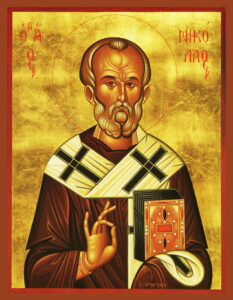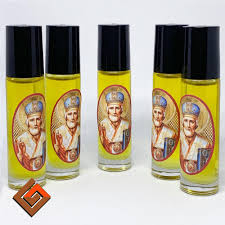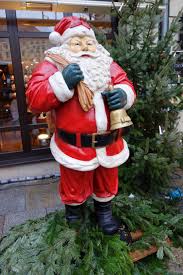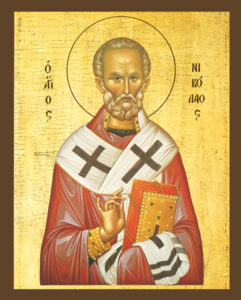Well, actually it was entirely on the wall! More on this later.

Saint Nicholas
This Sunday December 6 is the feast of Saint Nicholas the Wonderworker of Myra in Lycia. Why December 6? Because that is the day he died, his “birthday” into Heaven.
This seems the right time to finish the story of how Saint Nicholas brought me into the Orthodox Church.
Saints and Icons
But first, Class, do you have any questions? Let’s hear them.
1 How do we know Decenber 6 is the actual day he died?
As with most saints in early times, not because careful written records were kept, but because the people of their home towns always commemorated them, year after year, on the day they died. And so it was with the people of Myra – which is a seaport on the south coast of Asia Minor, now part of Turkey. So as Nicholas’ fame spread throughout the world he continues to be commemorated on December 6.
2 How do we know he is really a saint, a “holy” man?
Partly because his people remembered him that way. But chiefly because of his remarkable wonders and miracles which began immediately after his death and have continued till this day. For one thing, his body began to exude fragrant liquid with healing properties. They called it myrrh (“Myrrh from Myra” – punsters in the early Church!) just to  give it a name, since nobody really knows what it is. I italicized the word “is” because his body continues to exude myrrh to this day. I brought a bottle of Saint Nicholas’ Myrrh home some years later, when I visited the place where his relics now lie – Bari, Italy. His body, after almost 1700 years, is still largely incorrupt.
give it a name, since nobody really knows what it is. I italicized the word “is” because his body continues to exude myrrh to this day. I brought a bottle of Saint Nicholas’ Myrrh home some years later, when I visited the place where his relics now lie – Bari, Italy. His body, after almost 1700 years, is still largely incorrupt.
If you want the whole story of how he got there, and then of how the modern world has turned him into a used car salesman, go to “The Real Santa Claus” at “Father Bill’s Blog Post 43” and “Father Bill’s Blog Post 44”. For “The Wonderful Works of Saint Nicholas”, go to “Father Bill’s Blog Post 63” and then “64” and “65”.
3 Why does Santa Claus always wear red?
I never thought anyone would ask that! Here’s my theory. Santa Claus had his origin in Saint Nicholas (“Twas the night before Christmas… and I knew in a moment it must be “Saint Nick” – though in the charming poem the “jolly old elf” who rode on a sleigh was hardly the holy Saint Nicholas whom the Church knows.) And if you want to know how he became Santa Claus… Well, say “Saint Nicholas, Santa Claus” three times fast, and you’ll get the gist of it. But back to the question: … why red? Follow closely now: the Orthodox liturgical color during the Advent (pre-Christmas) Fast is red.
had his origin in Saint Nicholas (“Twas the night before Christmas… and I knew in a moment it must be “Saint Nick” – though in the charming poem the “jolly old elf” who rode on a sleigh was hardly the holy Saint Nicholas whom the Church knows.) And if you want to know how he became Santa Claus… Well, say “Saint Nicholas, Santa Claus” three times fast, and you’ll get the gist of it. But back to the question: … why red? Follow closely now: the Orthodox liturgical color during the Advent (pre-Christmas) Fast is red.  Nicholas was an Orthodox bishop who died during Advent, which I think explains why he is always depicted in our icons wearing red. In classical Western art he wore Western Bishop’s vestments, but still in red. And when Western secular culture transmogrified him into Santa Claus, he kept the color red. That’s my theory, and I’m sticking to it.
Nicholas was an Orthodox bishop who died during Advent, which I think explains why he is always depicted in our icons wearing red. In classical Western art he wore Western Bishop’s vestments, but still in red. And when Western secular culture transmogrified him into Santa Claus, he kept the color red. That’s my theory, and I’m sticking to it.
4 Are ancient saints really still active in the life of the Church? How can this possibly be? After they die aren’t good people off in Heaven, or maybe they’re sleeping till the Last Day.?
Friend, you must be of Protestant persuasion. Let me explain. Start, for example, with Christ’s answer to the Sadducees: “He is not the God of the dead, but of the living, for to him all are alive Luke 20:38 Then consider: Jesus Christ, by his Incarnation, Resurrection and Ascension has united Heaven and earth. He has abolished the boundaries between them. The gates are no longer closely guarded, Now, just as people on this side often step in to help us when we need it, so from time to time do the Great Ones from over There. And then there is the 2000 year experience of the Church. Explain it as you will, Saints keep showing up.
6 When we ask God or His servants the Saints and there are miracles, how can we know that they wouldn’t have happened anyway?
We can’t prove it. Life isn’t like that. But sometimes when the “coincidence” is remarkable enough, it’s very hard to believe that there isn’t Someone or someone behind it. Now, the story that I’m about to tell you… well, honestly it’s as close to proof as I know. To me there seems nothing “chancy” about this.
9 But what does this have to do with the icon of Saint Nicholas you brought home from Greece? How can icons do anything?
Of course, icons in and of themselves can’t. They’re just wood and paint. It’s the person depicted, whether Our Lord or His Blessed Mother or the Saint. When I brought that icon back, I never could have imagined… If you don’t, you’re about to find out.
Alright, class, if there are no more questions, let’s proceed.
I bring the Saint Nicholas Icon home.
Forgive me, for talking so much about myself and what happened to me. But I’ve been wanting for a long time to tell this story in full, and I’m going to do it. I thought at the time and still think it was wonderful. It still gives me the holy chills. If it’s of any help to you, God bless you.
The last two weeks I told you what caused me to buy that old icon of Saint Nicholas while I was in Greece. Looking back, I see that ![]() he had me in his sights. He was working on me.
he had me in his sights. He was working on me.
Now I was about to discover for myself how Saints and icons can “work”.
I hung the Saint Nicholas icon on the wall of my Episcopal church with a candle hanging before it, because I figured that’s what you do with icons. (We were kind of “high church” Anglican, and I could get away with that.) Then, other than lighting the candle, I ignored him.
By the way, I also brought back an icon of Christ and hung it in my office. As I went about my work I kept getting the feeling someone was staring at me. I’d look up and Someone was.
I discover I needed to be Orthodox
As I said, before I went to Greece I already suspected Orthodoxy was the best of the lot. Then I came back from Greece in love with Orthodoxy, wanting to be Orthodox. But I had to know why. I had to understand. It’s wrong to go with the heart alone. (I mean, if I had fallen in love with a woman, and then researched and she was already married…) So I started reading everything I could find about the Orthodox Church and also about Greece. It took about six months. I suppose it might have happened with any Orthodox book, but it was in the middle of a book of Father Alexander Schmemann’s talks called Church, World, Mission, that my mind flipped. Suddenly I was no longer a Western Christian. I was an Eastern Christian, Eastern Orthodox. I didn’t just want to become Orthodox. In my heart and mind and conscience I needed to.
Here’s how my understanding flipped. I had always thought that Christianity was held together by control, external authority, whether the Papacy nor the Holy Scriptures or just power. It was now obvious that wasn’t working anymore. Many Roman Catholics were ignoring the Pope. Going from parish to parish you couldn’t tell what to expect. The Papacy was losing control. Likewise, Protestants were taking the Scriptures in a multitude of different directions or ignoring the Bible altogether, and there were now thousands of different Protestant denominations, all teaching different things. Nothing was stable in Western Christianity any more. “Control” wasn’t working.
Before I became Orthodox, my Anglican friends warned me that though the Orthodox Church was the last “hold out”, it also would fall to secular pressures that have torn Western denominations apart.
But it hasn’t happened, even though Orthodoxy has lived in Western society for well over a century now. We Orthodox sometimes have foolish divisions because of politics, like the present kerfuffle between Moscow and Constantinople. And we have minor differences – the language and music used in worship, for example. But in Faith and worship and moral teachings, Eastern Orthodoxy is still solid as the Rock of Gibraltar,
Why is this so? Father Schmemann explained: It’s because Orthodoxy isn’t imposed on anyone from the outside. Orthodoxy is written in peoples’ hearts and souls. It’s internal, not external. It’s what had been prophesied: “This is the covenant I will make with them after that time, says the Lord. I will put my laws in their hearts, and I will write them on their minds.” Hebrews 10:16 As an Orthodox priest once said to me, “Our people just know who they are.” Not that all of us practice it well, God knows. But it wouldn’t occur to anybody to question what the Orthodox Faith is. It just IS.
This is partly because Orthodox all worship and pray in the same way and have since the time of the Fathers. Therefore we all share the same experience of God and His saints. Also, we haven’t had any Reformations or Counter-reformations or other upheavals to unbalance us. We’ve sailed over it all. But in the end I think it’s just the Holy Spirit working in the Church Jesus Christ founded and prayed for: “May they all be one, as I and the Father are one.” And so we still are.
I don’t think I said that well. You should read Father Schmemann. Anyway, today while everybody else is flailing about theologically, the Orthodox Church is not.
Am I wandering from the story of Saint Nicholas? No. Hang on a few more minutes. He and his icon will make their big surprise appearance at the very end.
But how ever was I to become Orthodox?
Now I knew I needed to go Home.
But how? I couldn’t imagine. We had two teenagers nearing college age. How could we afford to make such a huge change now?
Also, as a pastor, I felt I couldn’t just abandon my people. They were lovely people, and I loved them. My parish was a gem, relatively untouched by the changes going on in the wider Episcopal Church. Was there a way to make my Episcopal church into an Orthodox church? Again, I couldn’t imagine.
Furthermore, my wife Dianna wasn’t ready for this. Along with me, she had given herself heart, mind and soul to trying to preserve traditional Christianity in the Episcopal Church, and we both agreed we had failed. Like me, she felt she had “loved and lost” – and she was not about to do that again. She hadn’t shared my “conversion experience” in Greece. So I decided, without telling her, that God’s sign to me that I should become Orthodox would be if she became truly enthusiastic about Orthodoxy. But she knew what was going on within me, and that made it awkward for both of us.
So… could I hang on and fake it for another twenty years till retirement, feeling like a Ford salesman who now believed in Hondas?
I was miserable. I was on edge. My parishioners could see it. My family was suffering from it. It was driving me crazy.
Saint Nicholas’ Icon begins doing strange things
Now at last, back to Saint Nicholas hanging there on the wall. We often had Evening Prayer, the Anglican equivalent of Orthodox Vespers. After we concluded one evening. a woman came up to me and said “That icon. Have you noticed how his expression changes?” I said “No……” But I started going over to check him out. And yes. She was right.
![]() Now, I don’t mean that the paint moved around. It didn’t. But sometimes Saint Nicholas was happy, sometimes displeased, sometimes stern, sometimes pleased.
Now, I don’t mean that the paint moved around. It didn’t. But sometimes Saint Nicholas was happy, sometimes displeased, sometimes stern, sometimes pleased.
I dared to share this peculiar experience with a few trusted friends who I hoped wouldn’t think I had lost my mind – as I hope you also do not! But that couldn’t have been. The woman had seen it too.
Someone suggested, “Maybe the icon is just reflecting your feelings at the time”. So I checked. No. Sometimes we were in sync, but at other times I would be happy about something, and he definitely was unhappy. Sometimes I would be upset about something, while his eyes were smiling.
I’ve enlarged it above. Can you see any ot this? Nor can I, not anymore.
I had no idea what was going on. It kind of scared me. Well, what was going on was that, through that old icon, Saint Nicholas had drawn me into relationship with himself.
One evening I came back from a clergy meeting. Our clergy who once had been so solid in the Faith were now all over the place. Those with disoriented teaching had taken over, even in our formerly “safe” Anglo-Catholic Diocese. I knew I didn’t belong anymore. I came home feeling I just had to get away. I had to be Orthodox. I was at my wits’ end.
That night after Evening Prayer I went over to Saint Nicholas, so frustrated I could hardly handle it. I looked up at the icon… and there was Saint Nicholas looking like the proverbial “cat that had swallowed the canary”. I “lost it”. I said to him almost in anger (out loud? I don’t know) “How can you hang there looking so smug and pleased with yourself, while I’m so miserable?”
And then my dear Saint Nicholas did something even more startling.
Please come back next week.
Next Week: The Story concludes.
Week after next: Peculiar Things in the Altar